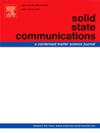Semiconducting transport properties of graphene doped by metal oxide
IF 2.4
4区 物理与天体物理
Q3 PHYSICS, CONDENSED MATTER
引用次数: 0
Abstract
The band gap research in graphene remains a critical topic for materials applications. Here, we report a band gap opening and p-type semiconducting property of graphene achieved through electrochemical doping on its surface. Manganese-oxide nanoparticles adsorbed on the graphene are used as dopants in an electrolyte, inducing the band gap opening and altering the electronic structure. Additionally, the fabricated graphene FET exhibits p-type semiconductor behavior. The temperature-dependent conductivity of the p-type doped graphene, at an applied potential of 1.5 V during electrochemical doping, indicates the formation of a 0.23 eV band gap, as determined from fitting the conductivity equation. The semiconducting properties of manganese-oxide doped graphene are attributed to the formation of manganese-oxide nanoparticles on the graphene surface.
金属氧化物掺杂石墨烯的半导体输运性质
石墨烯的带隙研究仍然是材料应用的一个重要课题。在这里,我们报道了石墨烯的带隙打开和p型半导体性质,通过电化学掺杂在其表面实现。吸附在石墨烯上的锰氧化物纳米颗粒被用作电解质中的掺杂剂,诱导带隙打开并改变电子结构。此外,制备的石墨烯FET表现出p型半导体行为。通过拟合电导率方程,p型掺杂石墨烯在电化学掺杂过程中,在1.5 V的施加电位下,其电导率随温度的变化表明形成了0.23 eV的带隙。氧化锰掺杂石墨烯的半导体特性归因于石墨烯表面形成的氧化锰纳米颗粒。
本文章由计算机程序翻译,如有差异,请以英文原文为准。
求助全文
约1分钟内获得全文
求助全文
来源期刊

Solid State Communications
物理-物理:凝聚态物理
CiteScore
3.40
自引率
4.80%
发文量
287
审稿时长
51 days
期刊介绍:
Solid State Communications is an international medium for the publication of short communications and original research articles on significant developments in condensed matter science, giving scientists immediate access to important, recently completed work. The journal publishes original experimental and theoretical research on the physical and chemical properties of solids and other condensed systems and also on their preparation. The submission of manuscripts reporting research on the basic physics of materials science and devices, as well as of state-of-the-art microstructures and nanostructures, is encouraged.
A coherent quantitative treatment emphasizing new physics is expected rather than a simple accumulation of experimental data. Consistent with these aims, the short communications should be kept concise and short, usually not longer than six printed pages. The number of figures and tables should also be kept to a minimum. Solid State Communications now also welcomes original research articles without length restrictions.
The Fast-Track section of Solid State Communications is the venue for very rapid publication of short communications on significant developments in condensed matter science. The goal is to offer the broad condensed matter community quick and immediate access to publish recently completed papers in research areas that are rapidly evolving and in which there are developments with great potential impact.
 求助内容:
求助内容: 应助结果提醒方式:
应助结果提醒方式:


